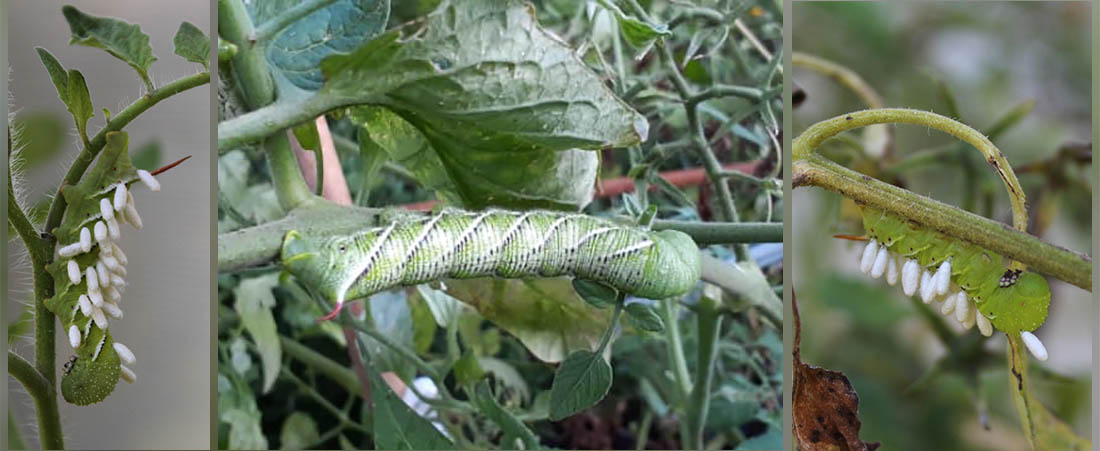
If the leaves of your tomato plant seem to suddenly be disappearing, take a closer look. There is a good chance there are one or more hornworms feeding on your plant.
Left unchecked, hornworms can quickly devour tomato leaves and even defoliate plants. Their green color provides a perfect camouflage – as a result, hornworms, which can grow up to 3” long, often aren’t noticed until they get quite large.
Hornworms are the caterpillar stage of sphinx moths. They get their name from the harmless spine, or horn, found on their back end. There are several different species of hornworms found in our region, two of which feed on tomato plants: the tobacco hornworm (Manduca sexta) and the tomato hornmworm (Manduca quinquemaculata).
These closely related insects look very similar and both turn into medium-sized brown moths. In the caterpillar stage, the color of the horn can help you tell the difference – tobacco hornworms have red horns while the horn on a tomato hornworm is blue. Watch this short YouTube video from NC State for more tips on how to tell the difference.
Determining which type of hornworm is eating your tomato plant is not necessary to decide what you should do about them. Both hornworms are voracious feeders that should be removed from tomato plants as soon as they are found.
If left to eat their fill, hornworms can kill young plants and weaken larger plants, resulting in reduced fruit production. We can have two or three generations of hornworms over the summer, so be sure to check your plants frequently for new caterpillars.
If you only have a few plants, checking your plants regularly and picking the caterpillars off by hand is an effective way to control them. You can drown the caterpillars in a bucket of soapy water or feed them to the chickens.
If handpicking is not feasible, there are several organic insecticides that control caterpillars if applied when the caterpillars are small. Examples include products that contain spinosad, B.t., neem oil or azadirachtin as the active ingredient.
When applying any pesticide, including organics, be sure to read and follow all label directions. Apply insecticides late in the evening when bees are not active to minimize harm to pollinators.
If you happen to find a hornworm that looks as if white cigars are growing out of its back, leave it in the garden. The “cigars” are actually the cocoons of braconid wasps. These tiny, non-stinging wasps parasitize hornworm caterpillars and help to naturally control their populations.
Other beneficial insects that help control caterpillars in the garden include assassin bugs, spiders, and predatory wasps such as yellow jackets and paper wasps.
Learn More!
Featured Creatures: Tomato and Tobacco Hornworm (University of Florida)
Braconid Wasps – parasites of hornworms (NCSU)
Tomato Insect Pests (Clemson Extension)
Organic and Less Toxic Insecticides (Clemson Extension)
Article was originally published on Chatham County Extension’s website.
By Charlotte Glen, NC State Coordinator for Extension Master Gardener Program
For more information, contact Dr. Tom Glasgow at the NC Cooperative Extension – Craven County Office at 252-633-1477.

